Overlocker Techniques

Overlocker Techniques: Mastering Your Serger
An overlocker, or serger, is a sewing machine designed to stitch and finish seams in one operation. It's a valuable tool for creating professional-looking garments and projects. Let's explore some key overlocker techniques.
Basic Overlocking
- Seam finishing: This is the most common use. The overlocker cuts and stitches the fabric edge simultaneously, preventing fraying.
- Joining seams: Overlock two fabric pieces right sides together for a clean and strong seam.
- Overcasting edges: Finish raw edges of fabric with an overlock stitch to prevent fraying.
Advanced Overlocking Techniques
- Gathering: Create gathers by adjusting the differential feed on your overlocker. This is useful for creating fullness in skirts, sleeves, and other garments.
- Flatlock seams: Create a flat, professional-looking seam by stitching two fabric pieces together with the overlocker.
- Coverstitch: While not strictly an overlocker technique, many modern overlockers have a coverstitch function. This creates a decorative stitch and finishes the seam in one step.
Tips for Overlocking Success
- Thread tension: Proper thread tension is crucial for good results. Experiment with different settings to achieve the desired stitch.
- Needle and knife adjustment: Adjust the needle and knife positions to suit your fabric thickness and desired stitch length.
- Practice: Overlocking takes practice to master. Start with simple projects and gradually increase the complexity.
